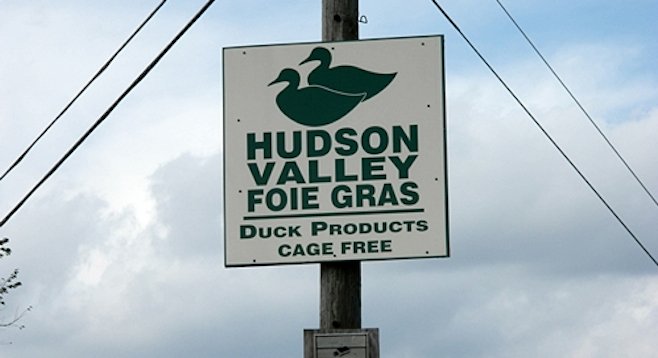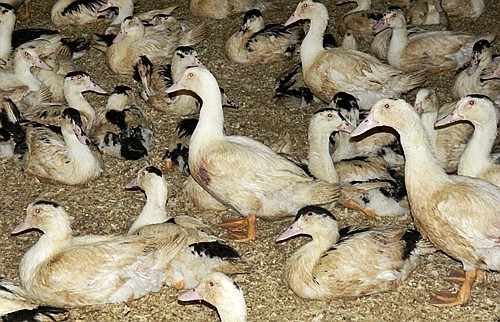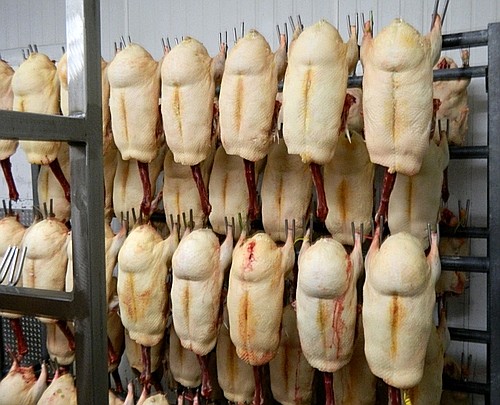 Facebook
Facebook
 X
X
 Instagram
Instagram
 TikTok
TikTok
 Youtube
Youtube

Whether you're a foodie, a farmer or an animal rights’ activist, you’ll learn a lot and clear up many misconceptions by visiting Hudson Valley Foie Gras.
You may have seen the episode of No Reservations with Anthony Bourdain doing the same. Hudson Valley Foie Gras is not in the Hudson Valley, but rather in Sullivan County, N.Y. Yes, this is the same foie gras farm – pretty much the last one standing in the U.S. – at the center of attention in Mark Caro’s book The Foie Gras Wars. Since the enacting of California S.B. 1520, which went into effect July 1, 2012, Californians cannot buy foie gras in their state.
Foie gras is the French term for “fat liver,” which ducks and geese get when they overeat. Farmers make the ducks overeat to create a better product, similar to Perdue creating bigger chicken breasts. Foie gras is a gourmet delicacy and has been since Egyptian times.
To understand that the production of foie gras is not cruel, you have to at least concede the concept of animals as an agricultural product. My last name is Fleishman, which means that at least since Napoleonic times – when Jews were forced to hastily adopt a last name – my father’s ancestors were meat butchers (opposed to chicken butchers, “Schecters”). I also write about and love food. Suffice to say, I have bought into the concept.
Even if you don’t – perhaps you're a vegan who doesn’t want to ever see a caged animal on a farm or a zoo – you have to admit that animals’ lives in the wild are very stressful. Who hasn’t seen Mutual of Omaha’s Wild Kingdom, where an animal is snatched up by a predator in the blink of an eye? What about the Geico ad where the antelopes taunt the unsuccessful lion, advising him to go vegan? Sweetness and how-de-do’s are just not part of nature.
That being said, such people as Pope Benedict XVI have come out against the concept of foie gras.
The neat part of Hudson Valley Foie Gras is that anybody (well, except for a couple of people they had legal wranglings with) can come visit the farm and its doings for free. You can be taken to any of the barns and meat production buildings. That’s a misconception some of the activists in Foie Gras Wars tried to stick in the public consciousness, that somehow there's a shell game of what's “really going on” and the "real thing" is kept from public view. It’s simply not true.

I saw it for myself. For 12 weeks, the ducks (and it’s always ducks here – geese make an unpredictable, albeit traditional food product) wander around on their own in a barn. They just lead an indoor duck life, eating when they want, drinking when they want. They don’t look stressed out and they aren’t quacking aggressively.
The life of a foie gras duck is much longer than the life of one raised solely for meat. The meat ones tend to top off at about 6 weeks.
For the last two weeks of their lives, the ducks go into pens of about 10. They aren’t in individual cages, though Canadians still adhere to this practice. The ducks have one particular feeder for the rest of their lives and the process takes just a few seconds. I saw a bunch being fed (video below), and it was much less arduous than when I had a feeding tube inserted in the hospital.

After the ducks are butchered, everything is used: the liver, the meat, feathers, bone meal.
As for the feeders themselves, like in all agricultural communities, they are mostly Latino. Hudson Valley Foie Gras makes sure they have living arrangements, pays bonuses and even has a chapel on site.
Sullivan County is mostly rural and working-class towns; you can’t really find a place to eat the foie gras locally to the farm. But if you’re visiting, check out nearby Monticello, N.Y.’s The Nugget. It’s a welcoming neighborhood tavern with a half dozen homemade soups at the ready and probably the best mac and cheese in the world.


Whether you're a foodie, a farmer or an animal rights’ activist, you’ll learn a lot and clear up many misconceptions by visiting Hudson Valley Foie Gras.
You may have seen the episode of No Reservations with Anthony Bourdain doing the same. Hudson Valley Foie Gras is not in the Hudson Valley, but rather in Sullivan County, N.Y. Yes, this is the same foie gras farm – pretty much the last one standing in the U.S. – at the center of attention in Mark Caro’s book The Foie Gras Wars. Since the enacting of California S.B. 1520, which went into effect July 1, 2012, Californians cannot buy foie gras in their state.
Foie gras is the French term for “fat liver,” which ducks and geese get when they overeat. Farmers make the ducks overeat to create a better product, similar to Perdue creating bigger chicken breasts. Foie gras is a gourmet delicacy and has been since Egyptian times.
To understand that the production of foie gras is not cruel, you have to at least concede the concept of animals as an agricultural product. My last name is Fleishman, which means that at least since Napoleonic times – when Jews were forced to hastily adopt a last name – my father’s ancestors were meat butchers (opposed to chicken butchers, “Schecters”). I also write about and love food. Suffice to say, I have bought into the concept.
Even if you don’t – perhaps you're a vegan who doesn’t want to ever see a caged animal on a farm or a zoo – you have to admit that animals’ lives in the wild are very stressful. Who hasn’t seen Mutual of Omaha’s Wild Kingdom, where an animal is snatched up by a predator in the blink of an eye? What about the Geico ad where the antelopes taunt the unsuccessful lion, advising him to go vegan? Sweetness and how-de-do’s are just not part of nature.
That being said, such people as Pope Benedict XVI have come out against the concept of foie gras.
The neat part of Hudson Valley Foie Gras is that anybody (well, except for a couple of people they had legal wranglings with) can come visit the farm and its doings for free. You can be taken to any of the barns and meat production buildings. That’s a misconception some of the activists in Foie Gras Wars tried to stick in the public consciousness, that somehow there's a shell game of what's “really going on” and the "real thing" is kept from public view. It’s simply not true.

I saw it for myself. For 12 weeks, the ducks (and it’s always ducks here – geese make an unpredictable, albeit traditional food product) wander around on their own in a barn. They just lead an indoor duck life, eating when they want, drinking when they want. They don’t look stressed out and they aren’t quacking aggressively.
The life of a foie gras duck is much longer than the life of one raised solely for meat. The meat ones tend to top off at about 6 weeks.
For the last two weeks of their lives, the ducks go into pens of about 10. They aren’t in individual cages, though Canadians still adhere to this practice. The ducks have one particular feeder for the rest of their lives and the process takes just a few seconds. I saw a bunch being fed (video below), and it was much less arduous than when I had a feeding tube inserted in the hospital.

After the ducks are butchered, everything is used: the liver, the meat, feathers, bone meal.
As for the feeders themselves, like in all agricultural communities, they are mostly Latino. Hudson Valley Foie Gras makes sure they have living arrangements, pays bonuses and even has a chapel on site.
Sullivan County is mostly rural and working-class towns; you can’t really find a place to eat the foie gras locally to the farm. But if you’re visiting, check out nearby Monticello, N.Y.’s The Nugget. It’s a welcoming neighborhood tavern with a half dozen homemade soups at the ready and probably the best mac and cheese in the world.
Comments